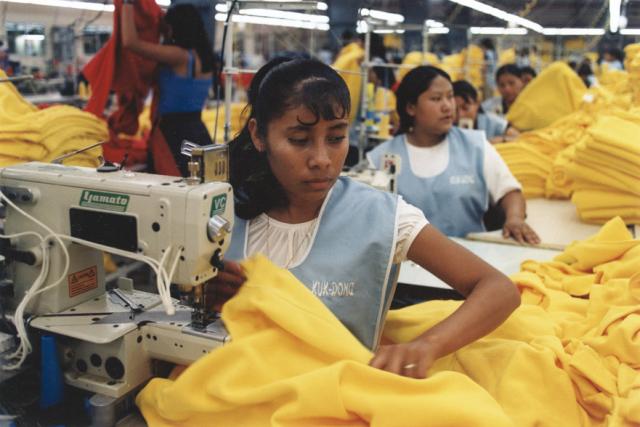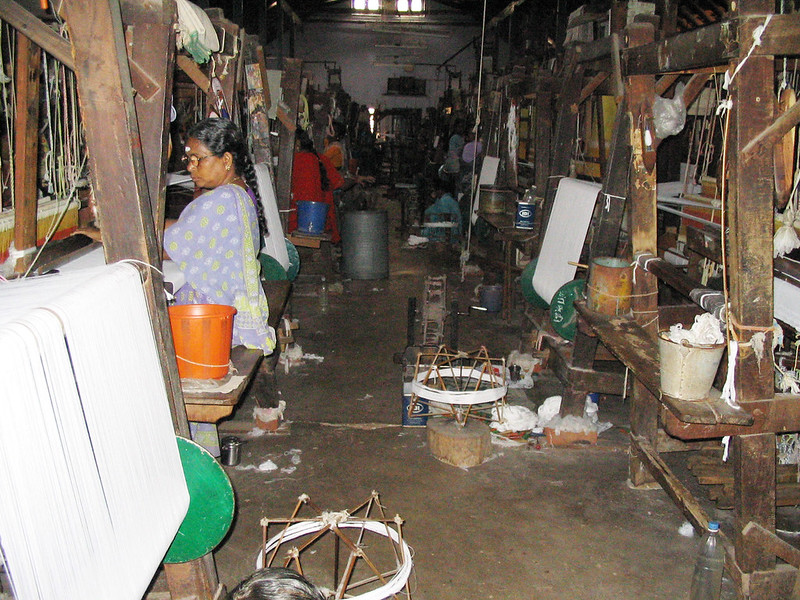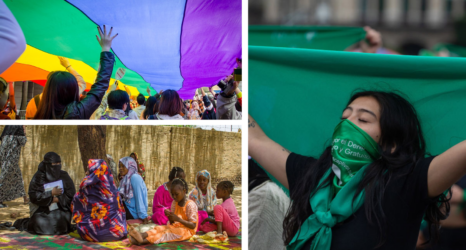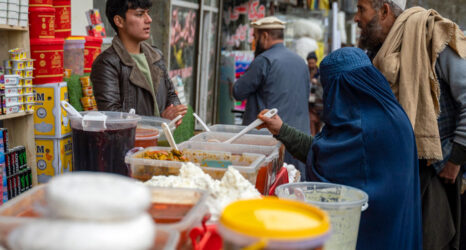“Article ignores the great strides we’ve made.” That was the headline in the Saipan Tribune in response to the Ms. cover story on abusive garment sweatshops, forced abortions and sex trafficking in the Northern Mariana Islands.
After the publication of “Paradise Lost,” Rep. George Miller (D-Calif.) reintroduced the United States-Commonwealth of the Northern Marianas Human Dignity Act to increase wages and improve working conditions on the islands, ensuring that factories do not “employ individuals under conditions of indentured servitude.” The bill passed in 2007 and was signed by President George W. Bush.
Acting U.S. Labor Secretary Patrick Pizzella worked in the 1990s to shield the Northern Mariana Islands from federal labor laws. With feminist gains under attack daily, and opponents of dignity for workers leading and staffing Trump’s Department of Labor, we’re republishing “Paradise Lost.”

The whir of hundreds of sewing machines reverberates in the thick, dusty air at the RIFU garment factory. Inside this large warehouse, behind a guarded metal fence, 300 employees— most of them Chinese women—cut, sew, iron and fold blouses with such efficiency and focus that they seem like machinery themselves. From piles of orange and pink fabric, the workers will produce over 15,000 garments today for J. Jill, Elie Tahari and Ann Taylor. These name-brand companies don’t own the factory; like Liz Claiborne, The Gap, Ralph Lauren and others, they subcontract production to factories like this, scattered around the tiny Micronesian island of Saipan.
Counters above the sewing machines indicate how many pieces the women have completed. According to workers, if they can’t finish a set quota of garments in a day, they may have to stay later and work for free, or they won’t be eligible for future overtime opportunities—which they desperately need.
Coming from rural villages and the big-city slums of poor Asian countries, these garment workers began their sojourn in the Marianas with a huge financial deficit, having paid recruiters as much as $7,000 to obtain a one-year contract job (renewable at the employer’s discretion). Many of them borrow the money—a small fortune in China, where most are recruited—from lenders who charge as much as 20 percent interest.
In a situation akin to indentured servitude, workers cannot earn back their recruitment fee and pay annual companysupplied housing and food expenses of about $2,100 without working tremendous hours of overtime. Before being able to save her first dollar, a worker who owes, say, $5,000 to her recruiter has to work nearly 2,500 hours at Saipan’s current minimum wage—which equals six more 40-hour workweeks than exist in a year.
And that’s assuming she gets paid. Increasingly, workers are filing formal complaints that they have not received their wages, with some women going without paychecks for over five months. Still, workers at RIFU and other Saipan garment factories labor six days a week, sometimes up to 20 hours a day.
“One or two days a week we’d work through an entire night, and I was exhausted,” says Chen Xiaoyan, 26, a nervous young woman with a thin ponytail who used to work for RIFU. “Sometimes we had no Sundays off either, but if you didn’t want to work they’d allow you no overtime at all as a punishment.”
The American consumers who wear the clothes these women produce probably have never heard of Saipan or the 13 other islands that comprise the Commonwealth of the Northern Mariana Islands (CNMI). Located just north of the U.S. territory of Guam, the islands were seized from the Japanese by U.S. military forces during World War II and served as the base for sending atomic bombs to Hiroshima and Nagasaki. After the war, the islands became a United Nations territory, administered by the United States.
Then, in 1975, the islands’ indigenous population of subsistence farmers and fishermen voted to become a commonwealth of the United States—a legal designation that made them U.S. citizens and subject to most U.S. laws. There were two critical exceptions, however: The U.S. agreed to exempt the islands from the minimum-wage requirements of the Fair Labor Standards Act (allowing the islands to set their own lower minimum wage, currently $3.05, compared to $5.15 in the U.S.) and from most provisions of the Immigration and Nationality Act. This has allowed garment manufacturers to import thousands of foreign contract guest workers who, ironically, stitch onto the garments they make the labels “Made in Saipan (USA),” “Made in Northern Marianas (USA)” or simply “Made in USA.”
The USA label tells customers “the quality is really good,” insists Cleofe de Guzman, a Filipina manager, as she walks down long, neat aisles past women pushing thin fabric through sewing machines. But to many Americans, adding USA to the label implies that goods are produced by Americans, not by foreign guest workers toiling under sweatshop conditions thousands of miles away.
The guest worker designation means that these foreign laborers can remain on the islands for an indefinite period but are not eligible for U.S. citizenship. If workers complain about conditions, not only can they be terminated at the whim of their employer, but because they’re exempt from U.S. immigration law, they can be summarily deported.
The local Department of Labor and Immigration, chronically underfunded, is of little help to them, taking six months to a year to complete reviews of complaints. There are no labor unions. While there is a Federal Labor Ombudsman’s office in Saipan, under the Department of the Interior’s Office of Insular Affairs, it can do little more than offer translation services and refer aggrieved workers to other agencies; it has no authority to investigate or prosecute.
“There are serious problems here and everybody knows it,” says the ombudsman, Jim Benedetto, as he stares out his Saipan office window at a sheet of rain. “There isn’t anyone who would say there aren’t worker abuses.” Such abuses have helped a highly profitable garment industry to flourish in the islands. At its peak, the industry annually exported to the U.S. garments worth $1 billion wholesale (with a retail value conservatively estimated at $2 billion). Considering that the success of the industry was tied closely to its low wages and exploitative guest worker program—and the fact that it was exempt from tariffs or quotas on exports to the U.S. mainland—it’s not surprising that both the Marianas’ government and the garment manufacturers have fought long and hard to maintain the deal.
Enter Jack Abramoff, who hardly needs an introduction. Caught in the crosshairs of one of the biggest congressional scandals in a century, the Georgetown-educated lawyer was once a high-flying Republican lobbyist on Capitol Hill; he now awaits sentencing on multiple criminal charges to which he has pled guilty: bribing public officials, fraud and tax evasion. While at the Washington, D.C., offices of the Preston, Gates, Ellis & Rouvelas Meeds law firm in 1995, Abramoff and his team were hired as lobbyists for the Commonwealth of the Northern Mariana Islands.
At the time, the islands’ sweet deal was in trouble, as a decade’s worth of rumblings about labor conditions and immigration abuses there had finally led members of Congress and the Clinton administra tion to press for legislation to eliminate the island’s exemptions from U.S. minimum wage and immigration laws. But Abramoff, using his close ties to Republicans in the House, worked mightily to block such reforms.
Many of his efforts focused on the House Resources Committee, which has jurisdiction over U.S. territories, including the Marianas. Although members of both houses of Congress and both political parties repeatedly pushed to bring the Marianas under federal immigration and minimum-wage laws, not a single legislative attempt has succeeded—most killed in the House Resources Committee.
Beginning in 1995 and continuing to the present day, at least 29 different bills—some to raise the minimum wage, some to close off the immigration exemption, and some to deny use of the “Made in USA” label on products of the CNMI—were introduced by Sens. Frank Murkowski (R-Alaska) and Ted Kennedy (D-Mass.) and by Reps. George Miller (D-Calif.) and David Bonier (D-Mich.). Twice—in 1995 and again in 2000— the U.S. Senate voted unanimously for Murkowski’s wage and immigration reforms only to have the bills die in the House Resources Committee.
“We were instrumental in first delaying Senate consideration of the Murkowski bill. We then stopped it cold in the House,” Abramoff wrote in a 2001 letter to the governor of the Marianas, Pedro P. Tenorio. Even a 1999 bill, sponsored by New Jersey Republican Rep. Bob Franks, died in the Resources Committee, despite having 243 co-sponsors—a substantial majority of House members, and enough to ensure passage on the floor.
Abramoff also cultivated powerful allies in the House leadership, notably Tom DeLay, who, as majority whip at the time, could keep a bill off the House floor even if the Resources Committee voted in its favor. According to the Associated Press, which, through an open records request, obtained the billing and correspondence records sent by Preston Gates to the Marianas government, Abramoff was in almost daily contact with DeLay’s top aides concerning Marianas-related matters. DeLay himself, the billing records showed, met or talked with Abramoff about the Marianas at least two dozen times in 1996 and 1997 alone.
Abramoff would later summarize his early Marianas lobbying successes in the 2001 letter to Tenorio: “We worked with the House leadership to assure the [minimum wage] bill would not move to the House floor, even if the [Resources] committee did act. It also allowed us to acquire some very powerful allies, such as Majority Whip Tom DeLay.” Three of DeLay’s former aides would end up joining Abramoff’s lobbying team and working on the Marianas account.
As Rep. Miller, the ranking Democrat on the House Resources Committee and a leading sponsor of reform legislation, told Ms., “The combination of DeLay and Abramoff kept anything from being considered in Congress for years. [The Northern Marianas] was a multimillion-dollar client of Abramoff, and DeLay was actively working to make sure his friend was able to protect his client.”
With the election of George W. Bush in 2000, Abramoff gained additional connections. After three Abramoff associates who had lobbied on behalf of the Marianas secured powerful positions in the Departments of Labor and Interior and in the General Services Administration, the lobbyist could gleefully report in his letter to Tenorio, “We have worked with W[hite] H[ouse] Office of Presidential Personnel to ensure that CNMI-relevant positions at various agencies are not awarded to enemies of the CNMI.”
First at Preston Gates and then with the law firm of Greenberg Traurig, Abramoff was well-compensated for his lobbying efforts, bringing in nearly $11 million in fees from the Marianas government and from the islands’ garment man ufacturers between 1995 and 2004. And his clients got exactly what they hoped for. “Our team has combated and defeated every single attack on the CNMI,” Abramoff wrote to Tenorio in 2001.
One of Abramoff’s favorite tactics for influencing members of Congress was to arrange Saipan junkets. As many as 100 people connected to the U.S. Congress—members themselves, or their staffers—traveled to the islands, sometimes with spouses or other family, including nearly half the Republican members of the House Resources Committee or their staffers. In addition to meetings with local officials, the trips— frequently all-expenses-paid—typically entailed a stay at the Hyatt Regency resort, snorkeling in the crystalline waters and golf at one of the islands’ four championship courses.
Among the visitors were DeLay, his wife and daughter, and six of his aides. During his 1998 New Year’s holiday trip, he told Saipan officials, as was later reported in The Dallas Observer, “When one of my closest and dearest friends, Jack Abramoff, your most able representative in Washington, D.C., invited me to the islands, I wanted to see firsthand the free-market success and the progress and reform you have made.”
At a New Year’s Eve dinner on Saipan, DeLay lavishly praised the governor—in a moment caught on camera and later shown by ABC’s 20/20—“You are a shining light for what is happening in the Republican Party, and you represent everything that is good about what we’re trying to do in America, in leading the world in the free-market system.”
Two years later, DeLay still saw the islands through rose-colored lenses, as he told The Washington Post: “[The CNMI] is a perfect petri dish of capitalism. …It’s like my Galapagos Island.”
Even today, DeLay remains a booster. When Ms. contacted him, he was in Texas and unavailable for comment, but his spokesman Michael Connolly said, “I can’t think of anything that would have changed his position on the Mariana Islands. He stands by the things he has said in the past and he stands by the votes he’s made that pertain to the islands.”
To find the dark underbelly of Delay’s “Shining light,” simply cross a busy Saipan street and walk a few yards down a dirt road. At 10:30 p.m., knots of Chinese women are just getting off work at a nearby garment factory and making their way through the steady rain that slices the black night.
These women eschew the more expensive, factory-owned barracks in favor of tiny homes constructed of corrugated tin, with thin wooden doors. In one tin dwelling, three women share a queen-sized bed that rests on a slab of concrete. The smell of frying vegetables wafts from the “kitchen”—a few hot plates and water-filled plastic buckets set outside on a concrete counter. Nine people share one toilet.
As they cluster outside, near a thin clothesline that doubles as a closet, one woman says that she’s worked here for two years and is nowhere close to paying the money back to her recruiter; the others shake their heads in agreement. Their fear is palpable: They’re afraid to use their names or to be photographed, even from the back.
“I heard that the lender might break my family’s legs if I don’t pay the money soon. I worry about it a lot,” one 35-year-old Chinese woman told Ms. a few days earlier, speaking through a translator. “I can’t imagine how long it will take to pay the money back. It’s very hard to be here. The only foods I can afford to buy are rice and some very cheap precooked vegetables. My teeth are always bleeding,” she says, her eyes like wet stone.
Most guest workers here are from poor Asian countries: China, the Philippines, Bangladesh, Thailand. Most have only a thirdor fourth-grade education. Of the nearly 30 workers interviewed by Ms., almost all had left children back home with relatives, hoping they’ll earn enough in Saipan to finance their offspring’s education. “The recruiter told us that in America it’s a very free country, and because we had never been here we believed them,” says a 22-year-old garment worker from China’s rural Fujian Province. “They were lying.”
Despite the squalid living conditions, the young guest workers want to stay at their jobs long enough to make their sacrifices worthwhile. But if they happen to get pregnant while working in Saipan, they’re faced with a new nightmare. According to a 1998 investigation by the Department of Interior Office of Insular Affairs, a number of Chinese garment workers reported that if they became pregnant, they were “forced to return to China to have an abortion or forced to have an illegal abortion” in the Marianas.
These days, pregnancy is still highly problematic for guest workers. Many believe that if they get pregnant their employers will not renew their contracts for another year. That’s essentially what happened to Chen Xiaoyan, the former RIFU worker. Two years ago, she became pregnant while visiting her boyfriend back in China. RIFU, although ostensibly responsible for workers’ medical care, told her they would not renew her contract unless she provided them an affidavit saying she would pay for all pregnancy-related medical expenses.
When she refused, Chen was fired. “It’s not fair and it’s not right,” she says. “I read from a book that the U.S. has the best law and protections for workers and I thought here it would be better than in China, but it isn’t.”
With few economic options, pregnant workers often feel they have no choice but to visit one of Saipan’s underground abortion providers. At least four acupuncture clinics offer pills to induce abortions, according to a local translator and former garment worker.
“I’ve driven four Chinese women to get abortions here,” he says, pointing to an inconspicuous cement building with red Chinese lettering and an English sign that reads “Acupuncture, Herbs, Massage Oils.” “I see girls whose bleeding did not stop, and on two incidents I had to take the girls to the hospital.”

While Congress wouldn’t help the garment workers, at least the courts have tried. In 1999, two federal class-action lawsuits were filed on behalf of Saipan’s garment workers, alleging violations of U.S. and international laws, including forcing employees to work “off the clock” and under hazardous working conditions. A third case, filed in California state court by Global Exchange, Sweatshop Watch, UNITE! and Asian Law Caucus, accused U.S. retail firms of engaging in false advertising by indicating their garments were “Made in USA.”
In 2003, all three suits were finally settled with the garment industry, for a total payout of $20 million. The money was earmarked for workers’ back pay, a fund to help out workers who couldn’t earn enough to repay their recruitment fees, and an independent oversight board to monitor working conditions at 27 factories on the islands. Although it wasn’t part of the settlement agreement, the pressure generated by the lawsuits and legislative reform efforts led most of the companies that once labeled their garments “Made in USA” to change their labels to read “Made in Saipan (USA)” or “Made in Northern Mariana Islands (USA).”
The monitoring program, while an important effort, has had mixed results, according to a U.S. government source in the Marianas speaking on background. Inspections only take place twice a year and the results are kept confidential—even the retailers who pay for the program don’t see them. The monitoring board has discretion to put factories on probation, but that has occurred only once. Moreover, the program will sunset in July 2007, and there are no other proposals on the table to replace it.
As for the $20 million settlement, only $5.8 million is earmarked for direct pay to workers, and very little of that has yet been paid out, according to Timothy Bellas, one of the monitors. Considering that the settlement was a class action on behalf of thousands of workers, no one can expect a large sum. The board has managed to disperse $328,000 to some 300 workers under the “Disappointed Expectations Fund,” but those moneys are now almost gone.
Meanwhile—and even more ominously—Saipan’s garment industry is declining. In January 2005, the GATT treaty, which had regulated all global trade in textiles and apparel since 1974, expired, eliminating quotas on textile exports to the U.S. The Northern Marianas had been attractive to garment makers because of its exemption from such quotas and from tariffs on goods shipped to the U.S. marketplace. Without those advantages, manufacturers are increasingly moving to such places as China, Vietnam and Cambodia, where they can pay even lower wages. Since the treaty’s expiration, seven factories have closed in Saipan, reducing the value of garment exports to half its 1999 peak and putting thousands of guest workers out of jobs. Some observers expect almost all factories to close by 2008, when a temporary restriction on Chinese apparel exports to the U.S. ends.
Considering that thousands of garment workers won’t be able to make enough money to pay back their recruitment fees in their home countries, what will they do if the factories close? Desperate to make money, some will undoubtedly turn to Saipan’s revitalizing tourist industry for jobs—but there are few to be had. In mid-December, nearly 1,000 workers lined up at the World Resort Hotel’s job fair, hoping to be among the lucky ones to fill fewer than 100 vacancies.
The Marianas Variety, Saipan’s local newspaper, reported that they were “mostly foreign workers who are experiencing problems getting their wages on time due to the worsening economic crisis on the islands.” If the legitimate tourist industry can’t provide for these workers, many of them will end up feeding the island’s other lucrative, burgeoning industry: sex tourism.

A naked Mongolian woman in a blond wig grinds her body around a silver pole. As music pounds through the small room, disco lights reveal an over-
weight, graying man in a Hawaiian shirt sitting in the corner, rubbing the thighs of another of the club’s dancers. A Japanese man with a sunburned nose stuffs dollar bills between a third woman’s legs while kissing and rubbing her breasts.
Outside the club, scantily clad Chinese girls, their hair dyed red or blond, sit on cheap white plastic chairs. “You want massage?” they call out.
“I can get you lots of Chinese girls,” says a man with a long fingernail, who calls himself Free. “You can take a girl back to her room and do whatever you want to her. All night.”
Teeming with strip clubs and massage parlors, the red-light district of Saipan has a magnetic draw for Asian businessmen, and for U.S. Navy sailors on three-day furloughs from duty stations in the Pacific and beyond. “Every time a ship arrives, they want women,” says a local taxi driver. “They say, ‘I want a nice fuck tonight. Give me a nice lady.’”
There are no reliable statistics, but an estimated 90 percent of the island’s prostitutes are former Chinese garment workers, who sell sexual favors for about $50 a night. Women recruited to work in Saipan as waitresses, or in other legitimate jobs, often end up being forced to become strippers or prostitutes, according to Timothy Riera, director of the Equal Employment Opportunity Commission’s Honolulu office.
“I thought I was coming to work as a dancer,” says a young Filipina woman, her voice barely a whisper as she speaks behind a curtain of her hair. “I was so surprised on the first night in the club when they told me I had to strip. The only way to get tips was by picking up the money with your breasts and your vagina. And there was a VIP room in the back where people could have sex.”
She points to a yellowed building with boarded-up windows and a security camera in the stairwell just off a busy street. There, she and the other strippers, all young Filipinas, were locked inside during the day and not allowed to leave except for work. Eventually, she and a friend escaped their employer after one of them rappelled down from a second-story balcony, us ing a rope made out of pants. “We felt so ashamed but we couldn’t back out,” says the young woman. “My family was relying on me for money.”
The guest worker system inherently denies rights to foreign employees, and this, paired with a lack of government intervention, creates a “breeding ground for slavery,” says Jolene Smith, executive director of Free the Slaves and an expert on human trafficking.
The saddest tale we’re told in the Marianas comes from a 24-year-old Filipina who is afraid to give her name. She and the 22-year-old woman sitting on a couch beside her came to Saipan last fall after recruiters offered them $400 a month to work as waitresses. Her 14-month-old son had died of dehydration the year before when she didn’t have enough money for his medication. So, she couldn’t turn down the recruiters, she whispers, because she believed it would enable her to provide a better life for her surviving 3-year-old son.
But, “they forced me to work like a prostitute,” she says. They were expected to have sex with as many as four men per day and given but one daily meal of noodles. “The boss lady told me if I don’t work, I won’t return back to the Philippines or see my son, and they will file a complaint and I’ll go to jail.” As she talks in the shelter where they’ve now hidden for five months, the other girl folds her body into a ball, tears streaking her face.
Tom Delay insists that he’s never heard such stories. “Sure, when you get this number of people, there are stories of sexual exploitation,” he told the Galveston County Daily News in May 2005. “But in interviewing these employees one-on-one, there was no evidence of any of that going on. No evidence of sweatshops as portrayed by the national media. It’s a beautiful island with beautiful people who are happy about what’s happening.”
Reformer Rep. George Miller, however, heard completely different stories on his visit to the islands. He and others hope that the indictment of Abramoff offers a chance for real change (see sidebar, to the right). Miller has also requested that Attorney General Alberto Gonzales and the current House Resources Committee chair, Richard Pombo (RCalif.), launch a full investigation of Abramoff’s dealings in the Marianas. So far, Pombo has yet to hold a hearing, but Miller says he will continue to push.
“It’s so ironic that people who talk about themselves as having family values are allowing these guest workers to be exploited in the harshest possible ways,” says Miller. “Their money and lobbying allowed the continuation of the worst of human behavior. Hopefully, now DeLay’s influence is diminished and there’s an opportunity to provide some protections.”
For guest workers in Saipan, drowning for years in wretched conditions, Miller’s legislation offers but a faint outline of a lifeboat on the horizon. “This is a dark, dark place in America,” says one former garment worker while driving beneath the warm tropical sun past one of the covert abortion clinics. “It’s a nightmare here.”
Erica Hsu and duVergne Gaines contributed additional research for this article.





